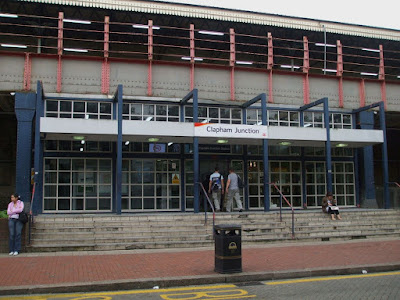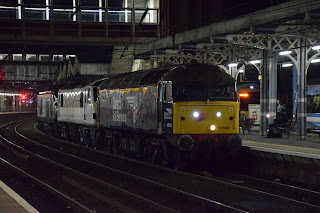Hello all, Liam here for a Station Focus post on Clapham Junction. If you are out and about in the railway in the South (Hampshire/Surrey/South London), you will more than likely have heard this station's name in service announcements. Clapham Junction is the UK's busiest railway station (in terms of train numbers - 180 per hour in peak times).
INTRODUCTION
Although appearing rather dismal at first, the Northern entrance to Clapham Junction station (as seen in the picture to the right) the entrance conveys large numbers of passengers, originating from a wide variety of backgrounds, ethnicities and classes, brightening up the doom and gloom of peak and rush hour travel with vibrance and a rich sense of multiculturalism.
HISTORY OF CLAPHAM JUNCTION
Built in the 1860s by a joint venture between the London & South Western Railway (L&SWR), the London, Brighton & South Coast Railway (LB&SCR) and the West London Extension Railway (WLER) for an interchange between the lines, the station's name is misused. Although namely Clapham Junction, the station actually lies in Battersea, a mile south east of Clapham. This has caused tensions between the railway and certain passengers, with some even campaigning for a change of the name of the station. The station is named Clapham Junction because it lies at the centre junction of 5 railway lines.
- Ludgate Junction - Eastern end of the South West Trains Windsor Line platforms to the West London Line.
- Falcon Junction - South end of the station, where the West London Line joins the Brighton Mainline Slow Lines.
- Latchmere Main Junction - Connects the West London Line to the Brighton Line at Falcon Junction.
- Latchmere SW Junction - Connects the West London Line to the Windsor Line at Ludgate Junction.
- West London Extension Junction - Junction for Waterloo, relaid for Eurostar ECS (empty coaching stock) moves to the West London Line from the Windsor Line.
- Pouparts Junction - Where the low-level and high-level approaches to Victoria split.
RAIL OPERATIONS
Serving Clapham Junction are 3 major Train Operating Companies (TOCs), as listed below.
- South West Trains (SWT) - Provide suburban stopping services from London Waterloo to Guildford (via Epsom or Cobham & Stoke D'abernon), Dorking, Woking, Weybridge, Hounslow, Shepperton, Strawberry Hill, Hampton Court & Chessington South. The majority of these services are operated by Class 455 EMUs (selected servies strengthened with a refurbished Class 456 set attached). Some services are operated by the recently refurbished Class 458/5s, and some peak services are operated by Class 450 Desiro units.
 |
| ©Liam Jenkins - Class 456s strengthen Class 455 services |
 |
©Liam Jenkins -
Recently refurbished Class 458/5s operate some services to Weybridge/Hounslow. |
South West Trains also operate faster, limited stop intercity services to a variety of destinations such as Weymouth, Poole, Portsmouth Harbour (Via Guildford/Basingstoke), Portsmouth & Southsea, Haslemere, Basingstoke, Alton, Southampton Central, Salisbury, Gillingham (Dorset), Exeter St Davids and Bristol Temple Meads. Services to Weymouth, Portsmouth Harbour, Portsmouth & Southsea, Haslemere, Poole, Alton, Basingstoke and Southampton Central are operated by a mixture of Class 444 and Class 450 Desiro units. Services to Exeter St Davids, Gillingham (Dorset), Salisbury and Bristol Temple Meads are operated by Class 158 and Class 159 Sprinter DMUs. Other services operated by SWT include Reading, Ascot and Aldershot, operated by Class 458s and Class 456s.
 |
| ©Liam Jenkins - A large fleet of Class 450 Desiro units provide fast, limited stop services. |
 |
| ©Liam Jenkins - A fleet of Class 158 & 159 Diesel Sprinter Units provide services to Exeter, Bristol and Salisbury on the non-electrified West of England line. |
- Southern - Provide suburban stopping services to a variety of suburban destinations, including Caterham, Tattenham Corner, Purley, East Croydon, West Croydon, Sutton, Epsom, Dorking, Horsham (via Sutton), Wimbledon, Guildford (peak only), London Bridge and Crystal Palace. These services are operated by Class 455/8 EMUs and Class 377/6 EMUs. Some services are also operated by Class 377/1-4 units, although these units are prioritised for faster, limited stop services.
 |
| ©Liam Jenkins - Southern Class 455/8 EMUs operate suburban services for Southern. |
 |
| ©Liam Jenkins - Southern Class 377/6 EMUs also operate suburban services, replacing aging Class 456 EMUs (now serving with SWT after a successful refurbishment) |
Southern also provide faster, limited stop services to a variety of locations in Sussex and Hampshire, including Brighton, Littlehampton, Bognor Regis, Portsmouth Harbour, Southampton Central, Ore, Hastings, Eastbourne, East Grinstead and Gatwick Airport. These are operated by Class 377/1, 377/4 and 377/6 units.
 |
| ©Liam Jenkins - Class 377/1 and 377/4 units make up the majority of fast services. |
In addition to the aforementioned services, Southern also offer a unique, frequent express service between London Victoria and Gatwick Airport, namely Gatwick Express. This service is every 15 minutes in each direction, and all services are operated by Class 442 Wessex units. Next year, newer Class 387 Electrostar units are to take over the Gatwick Express shuttles, providing an uncertain future for the iconic Class 442 units, causing tensions between rail enthusiasts and the Department for Transport (DfT).
 |
| ©Liam Jenkins - Class 442 Wessex units operate frequent Gatwick Express services between London and Gatwick Airport every 15 minutes. |
- London Overground - Owned by TfL (Transport for London), London Overground offer frequent services from Clapham Junction to Stratford and Highbury & Islington. These are operated every 15 minutes, and are served by Class 378 Capitalstar units.
 |
| ©Liam Jenkins - Class 378 Capitalstar units form all London Overground services out of Clapham Junction. |
CLAPHAM RAIL DISASTER
On the morning of 12th December 1988, two collisions occuring slightly South-West of the station involving 3 commuter trains resulted in 35 fatalities and over 100 injuries. The collision was caused by a signal failure due to a wiring fault. New wiring had been installed, but the old wiring had been left connected at one end, and loose and uninsulated at the other. An independent inquiry, chaired by Anthony Hidden, QC, found that the signalling technician responsible had not been told his working practices were wrong and his work had not been inspected by an independent person. He had also worked a seven-day week for the previous thirteen weeks.
 |
| Clapham Rail Disaster |
British Rail were fined £250,000 for violations of health and safety law in connection with the accident.
That's it for me today, thank you all for reading, we hope you have learnt something interesting and that you will share this post with your friends!
Andy is here tomorrow for the week review!

















